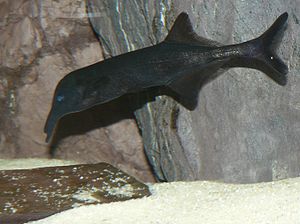Campylomormyrus elephas
| Campylomormyrus elephas | ||||||||||||
|---|---|---|---|---|---|---|---|---|---|---|---|---|

Campylomormyrus elephas |
||||||||||||
| Systematics | ||||||||||||
|
||||||||||||
| Scientific name | ||||||||||||
| Campylomormyrus elephas | ||||||||||||
| ( Boulenger , 1898) |
Campylomormyrus elephas is a species of African freshwater bony fish native to Africa. A German name for this fish is not yet known.
description
Campylomormyrus elephas has a streamlined body shape and a long trunk-like mouth process. The appearance of these animals is dominated by gray tones that are decorated with lighter stripes. The long tail stem is another characteristic of these fish. Like almost all species of the Mormyridae , this species also has an electrical organ and can therefore orient itself in cloudy water. With their big eyes, these fish can see very poorly. The final size of these animals is about 40 centimeters. It is difficult to separate the sexes because males and females are very similar in appearance. Campylomormyrus elephas is rather shy and jumpy.
Fin formula : dorsal 31, anal 34.
Way of life
In its natural habitat, Campylomormyrus elephas is usually found in larger flocks. However, this fish is nocturnal and usually hides under stones or roots during the day. At dusk it opens up and digs for worms with its "trunk" in the mostly muddy ground around it.
distribution
Its distribution area is the entire Congo Basin , where it prefers to inhabit high-flowing river sections. Type location of this fish is the catchment area of the Zaire. He mostly avoids colder river sections, his comfortable temperature is 26 to 28 ° C.
Aquaristics
Since this fish is very large at 40 centimeters, it is more suitable for large show aquariums, and therefore rather irrelevant for private keeping. In addition, he feels most comfortable in groups of seven or more animals, in smaller groups weaker animals are usually suppressed.
Sources and further information
literature
- Matthias Glaubrecht : Evolution in Action , ISBN 978-3-642-12425-9 .
- Rüdiger Riehl : Aquarium Atlas, Volume 3 , ISBN 3-88244-053-8 .
Web links
- Campylomormyrus elephas on Fishbase.org (English)
- Campylomormyrus elephas inthe IUCN Red List of Endangered Species 2013.2. Posted by: Moelants, T., 2009. Retrieved January 12, 2014.
